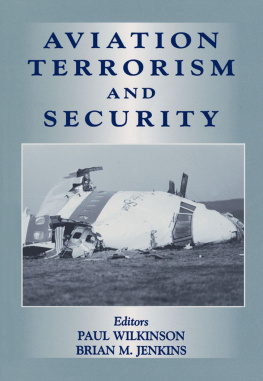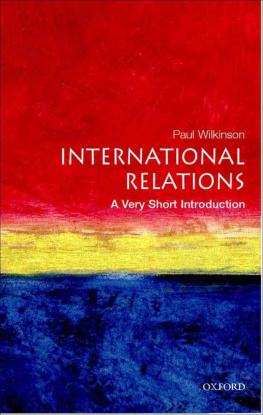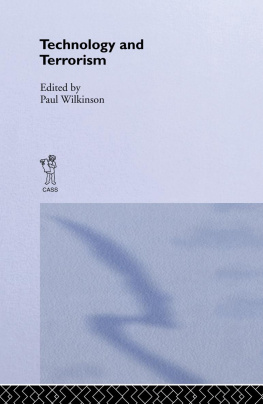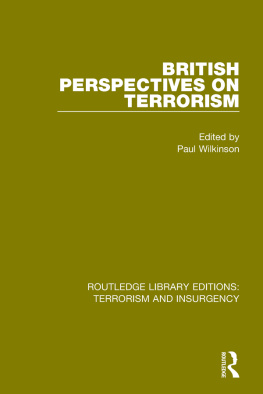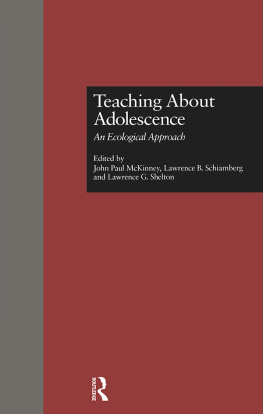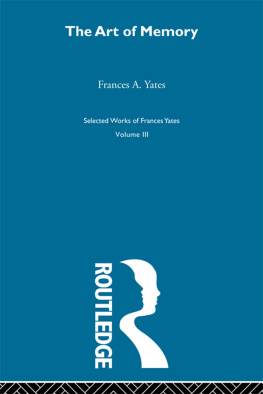First published in 1999 in Great Britain by
FRANK CASS PUBLISHERS
Newbury House, 900 Eastern Avenue,
London, IG2 7HH
and in the United States of America by
FRANK CASS PUBLISHERS
c/o ISBS
5804 N.E. Hassalo Street
Portland, Oregon 97213-3644
Website: http://www.frankcass.com
Copyright 1999 Frank Cass & Co. Ltd
British Library Cataloguing in Publication Data
Aviation terrorism and security. (Cass series on
political violence; no. 6)
1. Airports Security measures. 2. Terrorism Prevention
3. Hijacking of aircraft Prevention
I. Wilkinson, Paul, 1937 II. Jenkins, Brian
363.2876
ISBN 0 7146 4906 6 (cloth)
ISBN 0 7146 4463 3 (paper)
ISBN 978-1-135-23121-7 (epub)
Library of Congress Cataloguing in Publication Data
Aviation terrorism and security / edited by Paul Wilkinson and Brian Jenkins
p. cm. (Cass series on political violence)
Includes bibliographical references and index.
ISBN 0-7146-4906-6 (hardcover : alk. paper). ISBN 0-7146-4463-3 (pbk. : alk. paper)
1. Airports Security measures. 2. Hijacking of aircraft. 3. Terrorism Prevention. 4. Aeronautics, Commercial Security measures. I. Wilkinson, Paul, 1937 . II. Jenkins, Brian Michael. III. Series.
HE9797.4.S4A94 1998 | 98-46469 |
363.2876dc21 | CIP |
This group of studies first appeared in a Special Issue on Aviation Terrorism and Security in Terrorism and Political Violence 10/3 (Autumn 1998) published by Frank Cass.
All rights reserved. No part of this publication may be reproduced, stored in or introduced into a retrieval system or transmitted in any form, or by any means, electronic, mechanical, photocopying, recording or otherwise, without the prior written permission of the publisher of this book.
Printed by Antony Rowe Ltd, Eastbourne
The aims of this volume are: first, to assess the changing terrorist threat to the security of civil aviation, including newly emerging threats; second, to review the effectiveness of some of the major policies and measures introduced at national and international levels to protect civil aviation; and third, to consider the merits of new or hitherto neglected approaches to preventing and combatting aviation terrorism.
A key advantage shared by our contributors is that in addition to their expertise in aviation terrorism and security they have a wide knowledge and understanding of the post-Cold War strategic environment and patterns of conflict. This provides the essential context for analysing not only the ever-changing phenomena of international and domestic terrorism worldwide, but also for interpreting the significant developments in aviation terrorism that are in large part shaped by these factors. If we fail to adequately understand the dynamics of the relationship between patterns of violence and conflict generally, and aviation terrorism in particular, how can we hope accurately to identify new threats and develop more effective means to counter them?
Ariel Meraris opening essay provides a fascinating statistical analysis of aviation terrorism trends since the upsurge of modern international terrorism in the late 1960s and early 1970s. Many non-specialists may be surprised at his depressing conclusion that, in spite of the significant improvements in aviation security achieved by certain countries and the efforts of international organisations such as the International Civil Aviation Organisation (ICAO):
In the recent decade, the average hijacker had an 81 per cent chance of actually seizing control of the airliner. The terrorist hijacker had an even higher chance of success 85 per cent. The rate of success in bombing attacks against airlines, the principal cause of death in attacks on commercial aviation, has also been appallingly high 76 per cent.
A great strength of Professor Meraris analysis is that it is both historically comprehensive and encompasses all the major forms of aviation terrorism attacks on airlines, airports and airline offices.
Ariel Merari observes that even in the recent decade, the rate of attacks is still quite high. Hence, despite the decline in the overall numbers of attacks on airliners during the 30 year period, the rate of attacks is still quite high. The magnitude of the threat is still a reason for worry. Complacent assumptions that the threat from aviation terrorism faded away after Lockerbie should be discarded. In 1996, the last year of Professor Meraris analysis, just over 10 per cent of all recorded acts of international terrorism were directed at aviation targets. They included a dozen hijackings, two attempted hijackings, half a dozen attacks on airline officers and an airport bombing; the year culminated in the crash of the hijacked Ethiopian Airlines Boeing 767 off the Comoro Islands with the loss of 127 lives. We need to add to this picture events such as the conviction of Ramzi Yousef for conspiring to create what US prosecutors called 48 hours of terror in the sky by plotting to bomb a dozen US airliners in mid-air in the Pacific region, the growing number of man-portable SAM attacks on aircraft, and the ominous possibility of terrorists emulating the Aum Shinrikyo Sarin gas attack on the Tokyo subway system, possibly by attacking a civil aviation target such as an airliner cabin or an airport lounge or terminal building.
Of course it is important to see the statistics on aviation terrorism in their proper context. In reality airlines are an extremely safe means of transport. In each decade since the mid-1940s, there has been a 40 per cent fall in the fatal accident rate for international scheduled flights. Indeed it is the incredibly good safety record of the worlds airlines that has helped to make air travel such a phenomenally successful mode of transport and one of the fastest growing industries in the world.
There is a compelling case to be made for an effective security system on grounds of the commercial interests of the civil aviation industry. The second Gulf War showed that if the public develop a real fear of flying and no longer trust the will and capability of governments and aviation authorities to prevent and deter terrorist attacks, they will desert the airways in droves. In the first week of the war, The Association of European Airlines claimed that its members had lost 25 per cent of their traffic. Airline Business estimated that the industry as a whole was losing approximately $1.5 billion per month in the immediate aftermath of the war. The industry has every reason to be apprehensive about the effects of any future major conflict in the Middle East, and the concomitant threat of increased terrorism. What counts is the publics


